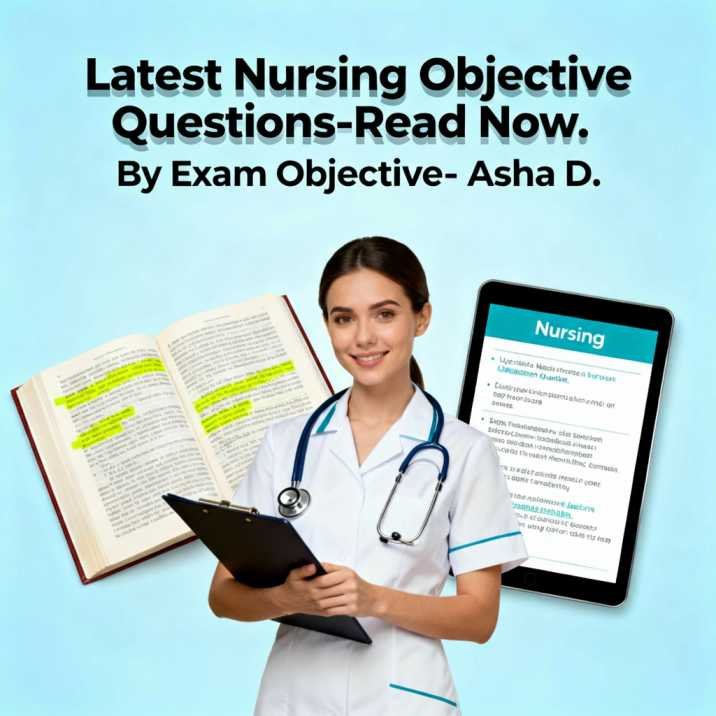🌍 Updated & Trending Nursing Exam Questions 🌍
Boost your preparation with the latest, exam-focused Nursing MCQs carefully designed for global nursing exams such as NCLEX, HAAD, MOH, Prometric, DHA, AIIMS, RRB, NHM, and various State Nursing Exams.
Each question builds your understanding from Medical-Surgical, Pediatric, Psychiatric, Community Health, and Obstetric Nursing domains.
Stay confident, revise daily, and keep progressing toward your goal of becoming a skilled and successful nursing professional. 💉📘🌟
🧠 Rationale: Glioblastoma multiforme (GBM) is the most aggressive and malignant primary brain tumor in adults.
It arises from astrocytic cells and grows rapidly, invading surrounding brain tissues.
Patients usually present with headache, seizures, or neurological symptoms that worsen fast.
Other tumors like meningioma are mostly benign, but GBM spreads quickly and has poor prognosis.
Hence, Glioblastoma multiforme is the most common malignant brain tumor in adults.
🩺 Rationale: In physical assessment, the general order is inspection → palpation → percussion → auscultation.
Palpation helps assess texture, temperature, and tenderness and is typically the last step in a full physical examination.
(Note: For abdominal exams, auscultation comes before palpation to avoid altering bowel sounds.)
Therefore, the correct answer is Palpation.
👶 Rationale: Placenta accreta occurs when the chorionic villi attach abnormally deep into the uterine wall, invading the myometrium partially or completely but without penetrating through it.
If invasion extends into the myometrium, it’s called placenta increta; and if it goes through the uterine wall reaching serosa or nearby organs, it’s placenta percreta.
Thus, in partial or complete attachment with the myometrium, the correct term is Placenta accreta.
🦵 Rationale: In rheumatoid arthritis, maintaining joint mobility helps prevent stiffness and deformities.
The nurse should encourage gentle movement within the limits of pain to preserve function and flexibility.
Prolonged immobility or bed rest increases stiffness and contractures, while forcing movement beyond pain can worsen inflammation.
Therefore, the correct action is to encourage movement within the limits of pain.
💊 Rationale: Contraceptive methods are usually safe for most women, including those who are lactating or on antihypertensive medications.
However, in cases of unexplained vaginal bleeding, contraception should be avoided until the underlying cause is diagnosed and treated, as it may indicate a serious condition such as malignancy or uterine pathology.
Hence, the correct answer is Unexplained vaginal bleeding.
🧊 Rationale: Renal calculi (kidney stones) often cause severe, colicky flank pain due to obstruction and irritation of the urinary tract.
The priority nursing action is to provide pain relief since the pain can be intense and debilitating.
After pain is controlled, the nurse should strain urine to collect stones and encourage fluids to promote passage.
Therefore, the first priority is administering pain medication.
👶 Rationale: The airway (or oropharyngeal airway) is a curved plastic device used during neonatal resuscitation to keep the infant’s airway open and maintain proper ventilation.
It prevents the tongue from obstructing the airway during bag and mask ventilation.
The endotracheal tube and laryngeal mask airway are used for advanced airway management, while the spirometer tube is not used in resuscitation.
Hence, the correct answer is Airway.
🧠 Rationale: Brown-Sequard syndrome is a type of incomplete spinal cord injury caused by damage to one side (hemisection) of the spinal cord.
It results in loss of motor function and proprioception on the same side of the injury, and loss of pain and temperature sensation on the opposite side.
This happens because motor fibers (corticospinal tract) cross at the brainstem, while sensory fibers (spinothalamic tract) cross soon after entering the spinal cord.
Therefore, the expected finding is loss of sensation on the side opposite the injury.
🌍 Nursing excellence knows no borders — prepare smart for global exams! 🌍
💡 Master each concept — your knowledge can save a life anywhere in the world! 💡
✅ Drop your answer below and challenge nurses worldwide!
🤝 Let’s learn together — inspire, support, and grow as global nursing professionals!
📚 Read More Nursing Objective Questions (MCQ)
Continue learning topic-wise! Tap any subject below to explore detailed Nursing MCQs with answers, explanations, and practice sets — designed for BSc, GNM, ANM, and MSc Nursing students.
📰 Related Nursing Articles & Updates

100 Nursing MCQ Questions with Answers — Must-Know Topics for Exam Preparation 🩺

Complete Collection of Nursing MCQ Questions – All Subjects in One Place 📘

🔥 Latest Nursing Objective Questions — Recently Added for 2025 Exams

🔥 Nursing multiple choice questions and answers pdf free download- By Asha D.